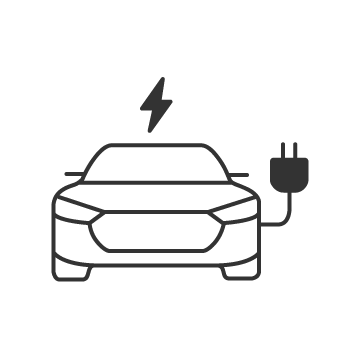As the automotive industry continues to embrace 48-V systems in hybrid electric vehicles (HEVs), the need for signal isolation for in-vehicle networking becomes even more critical. The features and benefits of higher voltages are significantly reduced without reliable, effective protection for low-voltage circuits.
However, understanding that you need to isolate signals from high-voltage events in 48-V vehicles is only half the battle. Unlike fully electric vehicles (EVs), HEVs use traditional combustion engines (ICEs) in addition to battery systems. ICEs generate high temperatures, often in excess of 125°C. To reliably operate in such environments, automotive systems – and the components from which they are built – must be able to withstand high temperatures, as defined by the Automotive Electronics Council (AEC)-Q100 “Failure Mechanism Based Stress Test Qualification for Packaged Integrated Circuits.”

Temperatures up to 150°C in your HEV/EV system? No sweat!
 |
The industry's first AEC-Q100 Grade 0 digital isolator, the ISO7741E-Q1, helps you save design time, cost and space in automotive designs where ambient operating temperatures can exceed 125°C.
|

What is the AEC-Q100 standard?
The AEC-Q100 standard outlines the specifications that integrated circuits (ICs) designed for use in automotive systems must meet for reliable operation. Since automotive systems are often subjected to temperature variations, a key specification of the AEC-Q100 standard is an IC’s ambient operating temperature range. The AEC-Q100 outlines operating temperature ranges of automotive-qualified ICs according to the different temperature grades, as shown in Table 1.
|
Grade
|
Ambient operating temperature range
|
|
Grade 0 (or A)
|
-40°C to +150°C
|
|
Grade 1 (or Q)
|
-40°C to +125°C
|
|
Grade 2 (or T)
|
-40°C to +105°C
|
|
Grade 3 (or I)
|
-40°C to +85°C
|
|
Grade 4 (or C)
|
-40°C to +70°C
|
Table 1: Automotive grades as defined by AEC-Q100
As the widest temperature range defined by the AEC-Q100, Grade 0 devices are typically designed for use in high-temperature systems, such as 48-V HEVs, since these vehicles can occasionally reach temperatures beyond 125°C due to their use of ICEs.
Since EVs don’t have an ICE, the ambient operating temperature does not typically exceed 125°C in most cases, so devices rated to Grade 1 will suffice.
Protecting low-voltage circuits with Grade 0 digital isolators
Let’s take a look at a few use cases to better illustrate the benefits of Grade 0 when isolating in-vehicle network signals, specifically focusing on digital isolators. Digital isolators are typically used between the different voltage domains (e.g. 48-V and 12-V) to protect circuits on the low-voltage side from the high-voltage side and reduce the impact of high-voltage common-mode noise on low-voltage side signals. Learn how to isolate CAN FD communications in HEV/EV systems with the application note, "Meeting the Timing Requirements of CAN FD in Isolated CAN Systems for HEV/EVs."
The starter/generator shown in Figure 1 is one example where a Grade 0 digital isolator, like the ISO7741E-Q1, can reduce design complexity while increasing signal protection in a high-temperature environment. In a starter/generator, a digital isolator and a Grade 0 Controller Area Network Flexible Data Rate (CAN FD) transceiver, such as the TCAN1044EV-Q1, can transfer data from the 48-V side to the 12-V side of a system. The 48-V electrical system sits in close proximity to the ICE; thus, any temperature rise on the 48-V system will affect the isolator that sits on the edge of the interface between the 48-V and 12-V sides. The temperatures of these systems go beyond 125°C up to 150°C for a short period, typically bounded by the mission profile or operating temperature profile, which varies by car manufacturer.

Figure 1: Digital isolator protecting the low-voltage side of a 48-V starter/generator system
Other applications that may benefit from higher-temperature-grade digital isolators include water pumps, cooling fans, soot sensors and traction inverters in 48-V HEVs. Most of these systems use digital isolators, along with a transceiver (CAN, CAN FD or Local Interconnect Network [LIN] communications protocols in most cases), as the communication interface. Figure 2 shows a heating, ventilation and air conditioning (HVAC) compressor module with an isolator used for communication from the MCU on the high-voltage side to the communication interface board on the low-voltage side.

Figure 2: Digital isolator protecting the low-voltage side of a 48-V HVAC compressor module
If the digital isolator is used at temperatures beyond its operational limit, it could result in either the degradation of the system timing specifications or no communication if the isolator stops functioning. Both of these cases are undesirable for a critical system like the starter generator. The standard way to ensure communication at all times is to use liquid and air cooling systems that reduce heat and maintain IC temperatures below their operational limits. But designing in elaborate air cooling systems can result in increased cooling system design costs, space and weight. Using ICs that meet higher ambient operating temperatures reduces the burden on cooling systems, making them simpler and more cost effective.
Most automotive-qualified digital isolators, including the ISO7741-Q1, meet the Grade 1 temperature range requirement of -40°C to 125°C, which is suitable for many automotive applications. However, in high-temperature systems, similar to the use cases discussed in this article, Grade 0 devices such as ISO7741E-Q1, will provide HEV/EV designers an alternate digital isolation solution that can reduce bill of materials and time to market, without compromising system performance.
Additional resources






